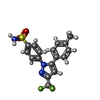+ Open data
Open data
- Basic information
Basic information
| Entry | Database: PDB / ID: 1oq5 | ||||||
|---|---|---|---|---|---|---|---|
| Title | CARBONIC ANHYDRASE II IN COMPLEX WITH NANOMOLAR INHIBITOR | ||||||
 Components Components | Carbonic anhydrase II | ||||||
 Keywords Keywords | METAL BINDING PROTEIN / 10-stranded / twisted beta-sheet | ||||||
| Function / homology |  Function and homology information Function and homology informationpositive regulation of cellular pH reduction / positive regulation of dipeptide transmembrane transport / regulation of monoatomic anion transport / secretion / cyanamide hydratase activity / cyanamide hydratase / arylesterase activity / regulation of chloride transport / Reversible hydration of carbon dioxide / morphogenesis of an epithelium ...positive regulation of cellular pH reduction / positive regulation of dipeptide transmembrane transport / regulation of monoatomic anion transport / secretion / cyanamide hydratase activity / cyanamide hydratase / arylesterase activity / regulation of chloride transport / Reversible hydration of carbon dioxide / morphogenesis of an epithelium / angiotensin-activated signaling pathway / positive regulation of synaptic transmission, GABAergic / regulation of intracellular pH / carbonic anhydrase / carbonate dehydratase activity / carbon dioxide transport / Erythrocytes take up oxygen and release carbon dioxide / Erythrocytes take up carbon dioxide and release oxygen / neuron cellular homeostasis / apical part of cell / myelin sheath / extracellular exosome / zinc ion binding / plasma membrane / cytoplasm / cytosol Similarity search - Function | ||||||
| Biological species |  Homo sapiens (human) Homo sapiens (human) | ||||||
| Method |  X-RAY DIFFRACTION / X-RAY DIFFRACTION /  MOLECULAR REPLACEMENT / Resolution: 1.5 Å MOLECULAR REPLACEMENT / Resolution: 1.5 Å | ||||||
 Authors Authors | Weber, A. / Casini, A. / Heine, A. / Kuhn, D. / Supuran, C.T. / Scozzafava, A. / Klebe, G. | ||||||
 Citation Citation |  Journal: J.Med.Chem. / Year: 2004 Journal: J.Med.Chem. / Year: 2004Title: Unexpected nanomolar inhibition of carbonic anhydrase by COX-2-selective celecoxib: new pharmacological opportunities due to related binding site recognition. Authors: Weber, A. / Casini, A. / Heine, A. / Kuhn, D. / Supuran, C.T. / Scozzafava, A. / Klebe, G. | ||||||
| History |
| ||||||
| Remark 999 | SEQRES Residues 125 and 127 are adjacent in the sequence. |
- Structure visualization
Structure visualization
| Structure viewer | Molecule:  Molmil Molmil Jmol/JSmol Jmol/JSmol |
|---|
- Downloads & links
Downloads & links
- Download
Download
| PDBx/mmCIF format |  1oq5.cif.gz 1oq5.cif.gz | 128.1 KB | Display |  PDBx/mmCIF format PDBx/mmCIF format |
|---|---|---|---|---|
| PDB format |  pdb1oq5.ent.gz pdb1oq5.ent.gz | 97.5 KB | Display |  PDB format PDB format |
| PDBx/mmJSON format |  1oq5.json.gz 1oq5.json.gz | Tree view |  PDBx/mmJSON format PDBx/mmJSON format | |
| Others |  Other downloads Other downloads |
-Validation report
| Summary document |  1oq5_validation.pdf.gz 1oq5_validation.pdf.gz | 772.8 KB | Display |  wwPDB validaton report wwPDB validaton report |
|---|---|---|---|---|
| Full document |  1oq5_full_validation.pdf.gz 1oq5_full_validation.pdf.gz | 775.5 KB | Display | |
| Data in XML |  1oq5_validation.xml.gz 1oq5_validation.xml.gz | 14.3 KB | Display | |
| Data in CIF |  1oq5_validation.cif.gz 1oq5_validation.cif.gz | 20.9 KB | Display | |
| Arichive directory |  https://data.pdbj.org/pub/pdb/validation_reports/oq/1oq5 https://data.pdbj.org/pub/pdb/validation_reports/oq/1oq5 ftp://data.pdbj.org/pub/pdb/validation_reports/oq/1oq5 ftp://data.pdbj.org/pub/pdb/validation_reports/oq/1oq5 | HTTPS FTP |
-Related structure data
| Related structure data | 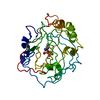 1cilS S: Starting model for refinement |
|---|---|
| Similar structure data |
- Links
Links
- Assembly
Assembly
| Deposited unit | 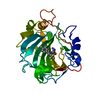
| ||||||||
|---|---|---|---|---|---|---|---|---|---|
| 1 |
| ||||||||
| Unit cell |
|
- Components
Components
| #1: Protein | Mass: 29157.863 Da / Num. of mol.: 1 / Source method: isolated from a natural source / Details: From human erythrocytes / Source: (natural)  Homo sapiens (human) / References: UniProt: P00918, carbonic anhydrase Homo sapiens (human) / References: UniProt: P00918, carbonic anhydrase |
|---|---|
| #2: Chemical | ChemComp-ZN / |
| #3: Chemical | ChemComp-CEL / |
| #4: Water | ChemComp-HOH / |
-Experimental details
-Experiment
| Experiment | Method:  X-RAY DIFFRACTION / Number of used crystals: 1 X-RAY DIFFRACTION / Number of used crystals: 1 |
|---|
- Sample preparation
Sample preparation
| Crystal | Density Matthews: 1.73 Å3/Da / Density % sol: 28.8 % | |||||||||||||||||||||||||||||||||||
|---|---|---|---|---|---|---|---|---|---|---|---|---|---|---|---|---|---|---|---|---|---|---|---|---|---|---|---|---|---|---|---|---|---|---|---|---|
| Crystal grow | Temperature: 277 K / Method: vapor diffusion, hanging drop / pH: 8.2 Details: Tris-HCl, NaCl, ammonium sulfate, pH 8.2, VAPOR DIFFUSION, HANGING DROP, temperature 277K | |||||||||||||||||||||||||||||||||||
| Crystal grow | *PLUS Temperature: 4 ℃ | |||||||||||||||||||||||||||||||||||
| Components of the solutions | *PLUS
|
-Data collection
| Diffraction | Mean temperature: 103 K |
|---|---|
| Diffraction source | Source:  ROTATING ANODE / Type: RIGAKU / Wavelength: 1.54178 Å ROTATING ANODE / Type: RIGAKU / Wavelength: 1.54178 Å |
| Detector | Type: RIGAKU RAXIS IV / Detector: IMAGE PLATE / Date: Nov 26, 2002 |
| Radiation | Monochromator: Osmic mirrors / Protocol: SINGLE WAVELENGTH / Monochromatic (M) / Laue (L): M / Scattering type: x-ray |
| Radiation wavelength | Wavelength: 1.54178 Å / Relative weight: 1 |
| Reflection | Resolution: 1.5→30 Å / Num. all: 35103 / Num. obs: 35103 / % possible obs: 91.5 % / Observed criterion σ(F): 0 / Observed criterion σ(I): 0 / Redundancy: 3.5 % / Rsym value: 0.093 / Net I/σ(I): 18.8 |
| Reflection shell | Resolution: 1.5→1.53 Å / Mean I/σ(I) obs: 2.8 / Num. unique all: 694 / Rsym value: 0.311 / % possible all: 37 |
| Reflection | *PLUS Highest resolution: 1.5 Å / Lowest resolution: 30 Å / Num. measured all: 123343 / Rmerge(I) obs: 0.093 |
| Reflection shell | *PLUS Highest resolution: 1.5 Å / % possible obs: 37 % / Rmerge(I) obs: 0.311 |
- Processing
Processing
| Software |
| |||||||||||||||||||||||||||||||||
|---|---|---|---|---|---|---|---|---|---|---|---|---|---|---|---|---|---|---|---|---|---|---|---|---|---|---|---|---|---|---|---|---|---|---|
| Refinement | Method to determine structure:  MOLECULAR REPLACEMENT MOLECULAR REPLACEMENTStarting model: PDB ENTRY 1CIL Resolution: 1.5→10 Å / Num. parameters: 20762 / Num. restraintsaints: 26228 / Cross valid method: FREE R / σ(F): 0 / Stereochemistry target values: Engh & Huber Details: ANISOTROPIC SCALING APPLIED BY THE METHOD OF PARKIN, MOEZZI & HOPE, J.APPL.CRYST.28(1995)53-56 ANISOTROPIC REFINEMENT
| |||||||||||||||||||||||||||||||||
| Displacement parameters | Biso mean: 22.3 Å2 | |||||||||||||||||||||||||||||||||
| Refine analyze | Num. disordered residues: 2 / Occupancy sum hydrogen: 1983 / Occupancy sum non hydrogen: 2296 | |||||||||||||||||||||||||||||||||
| Refinement step | Cycle: LAST / Resolution: 1.5→10 Å
| |||||||||||||||||||||||||||||||||
| Refine LS restraints |
| |||||||||||||||||||||||||||||||||
| Software | *PLUS Name: SHELXL / Version: 97 / Classification: refinement | |||||||||||||||||||||||||||||||||
| Refinement | *PLUS Highest resolution: 1.5 Å / Lowest resolution: 10 Å / % reflection Rfree: 5 % / Rfactor Rfree: 0.184 / Rfactor Rwork: 0.127 | |||||||||||||||||||||||||||||||||
| Solvent computation | *PLUS | |||||||||||||||||||||||||||||||||
| Displacement parameters | *PLUS | |||||||||||||||||||||||||||||||||
| Refine LS restraints | *PLUS
|
 Movie
Movie Controller
Controller



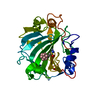
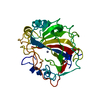
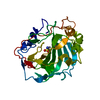

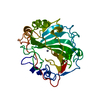
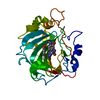
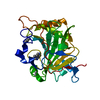
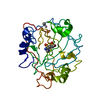
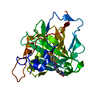


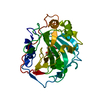
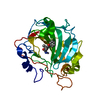
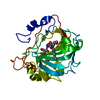
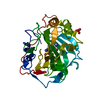
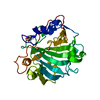
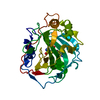

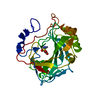

 PDBj
PDBj



